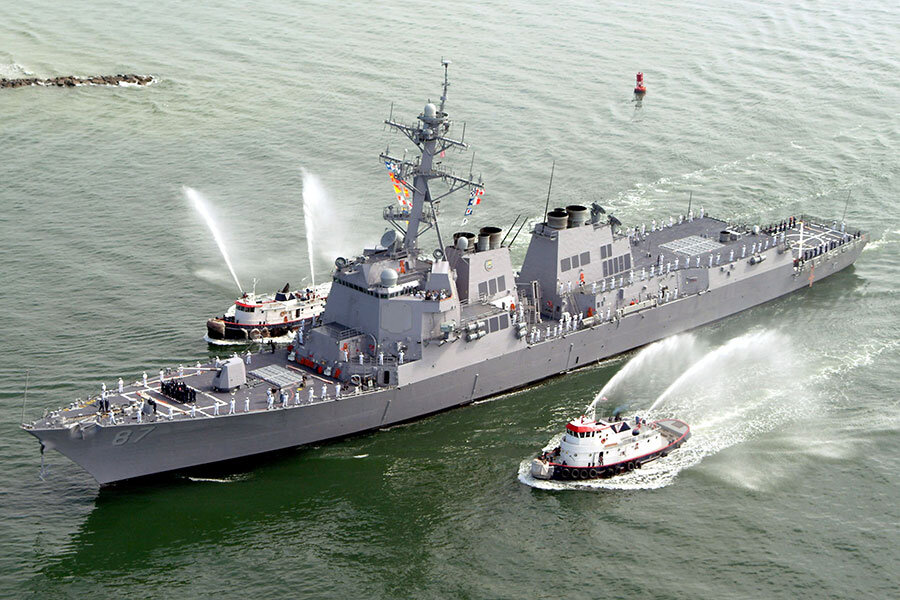Did Yemeni rebels just fire on a US warship?
Loading...
| DUBAI, United Arab Emirates
Two missiles fired from rebel-held territory in Yemen landed near an American destroyer in the Red Sea, the US Navy said Monday, the second such launch targeting ships in the crucial international waterway in recent days.
The missile launches Sunday came as a ballistic missile fired from Yemen apparently targeted a Saudi air base near the Muslim holy city of Mecca, the deepest strike yet into the kingdom by Shiite rebels and their allies.
Yemen's Shiite rebels known as Houthis and their allies offered no reason for the launches, though they came after a Saudi-led airstrike targeting a funeral in Yemen's capital killed over 140 people and wounded 525 on Saturday.
In a statement, the Navy said no American sailors were injured and no damage was done to the USS Mason, an Arleigh Burke class of guided missile destroyer whose home port is Norfolk, Virginia. Lt. Ian McConnaughey, a spokesman for US Navy Forces Central Command, said that it's unclear if the USS Mason was specifically targeted, though the missiles were fired in its direction over an hour's time period, starting at around 7 p.m.
An American defense official said the USS Mason used onboard defensive measures after the first missile was fired, but it wasn't clear if that caused the missile to splash harmlessly into the sea. The destroyer at the time of the missile fire was north of the Bab el-Mandeb Strait, which serves as a gateway for oil tankers headed to Europe through the Suez Canal, the official said.
The official spoke on condition of anonymity to discuss details of the incident that haven't been made public.
However, the Houthi-controlled SABA news agency of Yemen quoted an anonymous army official denying its forces fired on the USS Mason, without elaborating.
Last week, an Emirati-leased Swift boat came under rocket fire near the same area and sustained serious damage. The United Arab Emirates described the vessel as carrying humanitarian aid and having a crew of civilians, while the Houthis called the boat a warship.
US Navy officials declined to immediately discuss what kind of rockets were used in the USS Mason incident.
Analysts with the Washington Institute for Near East Policy suggested in a report that the Houthis may have targeted the Emirati ship with an Iranian anti-shipping cruise missile, based on purported video of the attack.
Shiite power Iran has supported the Houthis, but denied supplying them with weapons. Any Iranian involvement could stoke tension between the Islamic Republic and the U.S., which already have had a series of tense naval encounters since the nuclear deal with world powers.
Meanwhile, Saudi state television aired a brief clip of what appeared to be a projectile that was said to have landed in Taif in the ballistic missile attack. The video shows the flash of an explosion, followed by images of emergency vehicles. Taif is home to Saudi Arabia's King Fahd Air Base, which hosts US military personnel training the kingdom's armed forces.
The Saudi military said the missile fired late Saturday night was intercepted and caused no damage. The US military's Central Command, which oversees troops in the Middle East, did not immediately respond to a request for comment.
Al-Masirah, a satellite news channel run by Yemen's Shiite rebels known as the Houthis, identified the missile as a local variant of a Soviet-era Scud missile. It said the Volcano-1 missile targeted the air base.
The Houthis have fired a series of ballistic missiles in Saudi Arabia since a kingdom-led coalition of Arab countries has launched an offensive against them in Yemen in March 2015. Most of those ballistic missiles have hit areas far closer to Saudi Arabia's border with Yemen, like an attack Friday night that targeted the southwestern city of Khamis Mushait.
In the Taif attack, however, the missile struck a target more than 520 kilometers (325 miles) from the border. Taif also is just outside of Mecca, which is home to the cube-shaped Kaaba that all of the world's Muslims pray toward.
The Saudi military also said it earlier intercepted another ballistic missile fired Sunday on the Yemeni city of Marib.
The Houthis gave no reason for their targeting of Taif, but it comes after a Saudi-led airstrike Saturday targeting a funeral in Yemen's capital, Sanaa. On Sunday, thousands marched through the streets of Sanaa to protest the strike, one of the deadliest single attacks in the impoverished Arab country's relentless civil war.
The Saudi Foreign Ministry said its U.N. mission sent a letter on Sunday to the Security Council, expressing the kingdom's "deep regret of the reported attack" on the funeral. Saudi officials have promised to investigate the bombing.
Yemen's war is largely overshadowed by the conflict against the Islamic State group elsewhere in the Middle East, though rights groups have mounted increased criticism of the Saudi-led airstrikes in recent months for killing civilians. The U.N. and rights groups estimate the conflict has killed at least 9,000 people and displaced nearly 3 million more.
___
Associated Press writers Maggie Michael in Sanaa, Yemen, and Lolita C. Baldor in Washington contributed to this report.







